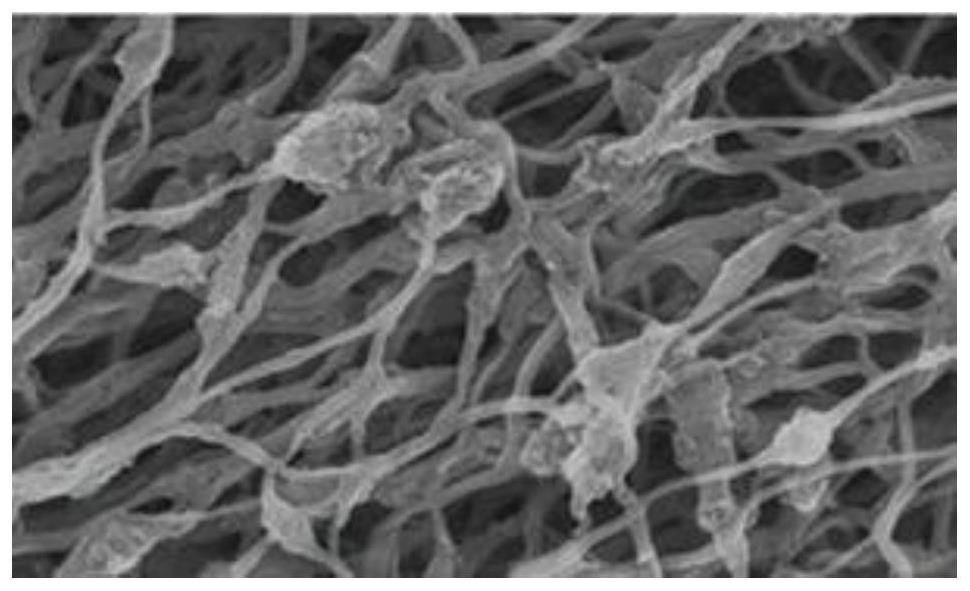Preparation method of composite proton exchange membrane for fuel cell
A proton exchange membrane and fuel cell technology, applied in fuel cells, circuits, electrical components, etc., can solve problems that affect the uniformity of the membrane, cannot control the temperature uniformity of the membrane material, and cannot solve the problems of catalyst adhesion on the proton exchange membrane. Achieve the effect of improving adhesion and improving thickness uniformity
- Summary
- Abstract
- Description
- Claims
- Application Information
AI Technical Summary
Problems solved by technology
Method used
Image
Examples
preparation example Construction
[0026] A preparation method for a composite proton exchange membrane for a fuel cell, comprising the following steps:
[0027] S1, preparation of perfluorosulfonic acid resin solution: F + Type perfluorosulfonic acid resin particles for H + Typing converts it to H + Type perfluorosulfonic acid resin: sequentially to F + Type perfluorosulfonic acid resin particles alkaline washing, washing, pickling, washing, drying. The specific steps are as follows: the F + Type perfluorosulfonic acid resin particles are soaked in alkaline solution at 60-100°C for 16-24h for hydrolysis treatment, soaked in deionized water at 40-80°C for 5-10h to neutral, and then soaked in acidic solution 4-8h, repeat 6-8 times, wash with deionized water, filter and dry to get H + type perfluorosulfonic acid resin. Then add it into a reaction kettle equipped with water and a high-boiling point solvent, heat and stir to dissolve, and obtain a perfluorosulfonic acid resin solution.
[0028] In the above ...
Embodiment 1
[0034] A preparation method for a composite proton exchange membrane for a fuel cell, comprising the following steps:
[0035] S1, preparation of perfluorosulfonic acid resin solution:
[0036] ① Soak F+ type perfluorosulfonic acid resin pellets in 15% potassium hydroxide aqueous solution at 90°C for 20 hours, and perform hydrolysis treatment to obtain K+ type perfluorosulfonic acid resin pellets. Then soak in deionized water at 60°C for 5 hours until neutral, then put it into 2mol / L hydrochloric acid aqueous solution, soak for 4 hours, repeat 6 times. Wash the granular material with deionized water, filter and dry to obtain H+ type perfluorosulfonic acid resin (PFSA);
[0037] ②Put the above-mentioned granules and water and MMB in a closed autoclave at a mass ratio of 8:1, heat and stir at 150°C for 4 hours to dissolve, and obtain a perfluorosulfonic acid resin (PFSA) with a mass fraction of 25% after cooling solution.
[0038] S2, the preparation of catalyst slurry
[00...
Embodiment 2~6
[0044] The difference between Examples 2-6 and Example 1 is that the pre-drying temperature in step S3 is different, the specific components are shown in Table 1, and other components, steps and parameters are the same.
[0045] The drying temperature of table 1 embodiment 1~6 step S3
[0046] project Pre-drying temperature primary drying temperature secondary drying temperature Example 1 60℃ 60℃ 100℃ Example 2 40℃ 60℃ 100℃ Example 3 50℃ 60℃ 100℃ Example 4 70℃ 60℃ 100℃ Example 5 80℃ 60℃ 100℃ Example 6 90℃ 60℃ 100℃
PUM
 Login to View More
Login to View More Abstract
Description
Claims
Application Information
 Login to View More
Login to View More - R&D
- Intellectual Property
- Life Sciences
- Materials
- Tech Scout
- Unparalleled Data Quality
- Higher Quality Content
- 60% Fewer Hallucinations
Browse by: Latest US Patents, China's latest patents, Technical Efficacy Thesaurus, Application Domain, Technology Topic, Popular Technical Reports.
© 2025 PatSnap. All rights reserved.Legal|Privacy policy|Modern Slavery Act Transparency Statement|Sitemap|About US| Contact US: help@patsnap.com



